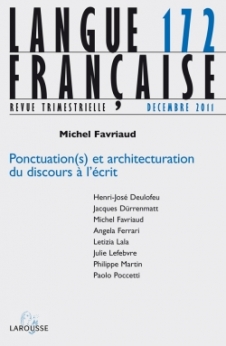
Langue française n° 172 (4/2011)
Pour acheter ce numéro, contactez-nous
Recevez les numéros de l'année en cours et accédez à l'intégralité des articles en ligne.
La raréfaction de l’usage du point-virgule tient principalement à la difficulté qu’il rencontre, depuis la faillite du modèle périodique, à justifier sa spécificité face à la virgule et aux deux-points. Une fois compris pourquoi le besoin s’est fait sentir à la Renaissance d’une multiplication des signes médians quand la virgule semblait pouvoir suffire, est étudié, dans un deuxième temps, comment les grammairiens qui se sont intéressés à la ponctuation se sont efforcés jusqu’à la normalisation du XIXe siècle de clarifier les différences et d’inscrire une hiérarchisation entre point-virgule et deux-points. Nous avançons des raisons qui tenaient presque toujours à une certaine idée de la période, et plus largement du texte, comme tout organisé. Celles-ci sont révélatrices, dans le même temps, des flottements qui affectaient et continuent d’affecter la pensée de l’autonomie plus ou moins grande d’unités syntaxiques internes à l’égard d’une unité plus grande définie en termes sémantiques plutôt qu’énonciatifs.
The depletion of the use of the semicolon is mainly due to the difficulty it meets, since the failure of the periodic model, to justify its specificity against the comma and the colon. Once understood why the need of a proliferation of median signs arose in the Renaissance when the comma seemed to be enough, is studied in a second time how the grammarians who were interested in punctuation have worked, till the grammatical normalization in the nineteenth century, to clarify the differences and to include a hierarchy between semicolon and colon. There were precise reasons relative to a certain idea of the period and, more broadly, of the text, as an organized entity. These were, at the same time, indicative of the indecision that affected and is still affecting the thinking of the autonomy of the internal syntactic units in respect of a larger one defined semantically rather than enunciatively.